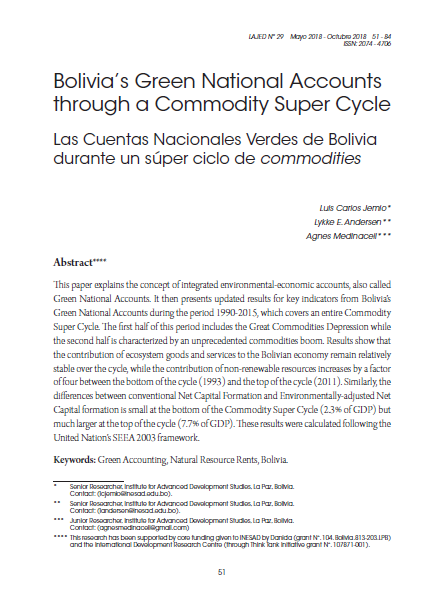The Bolivia’s Green National Accounts through a Commodity Super Cycle
DOI:
https://doi.org/10.35319/lajed.201829354Keywords:
Green Accounting, Natural Resource Rents, BoliviaAbstract
This paper explains the concept of integrated environmental-economic accounts, also called Green National Accounts. It then presents updated results for key indicators from Bolivia’s Green National Accounts during the period 1990-2015, which covers an entire Commodity Super Cycle. The first half of this period includes the Great Commodities Depression while the second half is characterized by an unprecedented commodities boom. Results show that the contribution of ecosystem goods and services to the Bolivian economy remain relatively stable over the cycle, while the contribution of non-renewable resources increases by a factor of four between the bottom of the cycle (1993) and the top of the cycle (2011). Similarly, the differences between conventional Net Capital Formation and Environmentally-adjusted Net Capital formation is small at the bottom of the Commodity Super Cycle (2.3% of GDP) but much larger at the top of the cycle (7.7% of GDP). These results were calculated following the United Nation’s SEEA 2003 framework.
Downloads
References
Andersen, L. E., J. Caro, R. Faris and M. Medinaceli. 2007. “Natural Gas and Inequality in Bolivia after Nationalization”. The Journal of Energy and Development, 31(2): 233-260.
Andersen, L. E., A. S. Doyle, S. del Granado, J. C. Ledezma, A. Medinaceli, M. Valdivia and D. Weinhold. 2016. Net Carbon Emissions from Deforestation in Bolivia during 1990-2000 and 2000-2010: Results from a carbon bookkeeping model. PLoS ONE, 11 (3): e0151241. doi:10.137/journal.pone.0151241.
Bartelmus, P. 2008. Quantitative Eco-nomics: How sustainable are our economies? Springer Science.
---------- 2015. “Do we need ecosystem accounts?”. Ecological Economics, 118, 292-298.
Bolivia. 2008. Segunda Comunicación Nacional del Estado Plurinacional de Bolivia ante la Convención Marco de Naciones Unidas sobre Cambio Climático. Ministerio de Medioambiente y Agua. Disponible en: http://unfccc.int/resource/docs/natc/bolnc2.pdf (diciembre).
---------- First National Communication to the UNFCCC. Ministry of Sustainable Development and Planning. Disponible en: http://unfccc.int/resource/docs/natc/bolnc1e.pdf (noviembre)..
Bolivia. Superintendencia Forestal. 1999. Potencial de los bosques naturales de Bolivia para producción forestal permanente. Edición y responsabilidad técnica: E., Dauber; R., Guzmán; J., Terán. Santa Cruz, Bolivia.
Christian, M. S. 2010. “Human Capital Accounting in the United States, 1994-2006”. Survey of Current Business, 90 (6): 31-36.
Conservación Internacional. 2016. Cuentas ambientales en los ecosistemas en San MartínPerú. Lima: Conservación Internacional y Gobierno Regional de San Martín.
European Parliament. 2011. “Regulation (EU) No 691/2011 of the European Parliament and of the Council of 6 July 2011 on European environmental economic accounts”. Official Journal of the European Union, L 192/1.
European Commission, International Monetary Fund, Organisation for Economic Co-operation and Development, United Nations, and World Bank. 2009. System of National Accounts 2008. New York: European Commission, International Monetary Fund, Organisation for Economic Co-operation and Development, United Nations, and World Bank.
Figueroa, E., C. Orihuela and E. Clafucura. 2010. “Green accounting and sustainability of the Peruvian metal mining sector”. Resources Policy, 35, 156-167.
Granado del, S., H. del Granado and L.C. Jemio. 2016. Yacimientos. In: L.E. Andersen, B. Branisa and S. Canelas (eds.), El ABC del desarrollo en Bolivia. Fundación INESAD, pp. 273-282. 14. Jemio, L. C. 2011. Cuentas ambientales: medioambiente y economía en Bolivia. La Paz: Fundación PIEB y Conservación Internacional- Bolivia.
---------- 2010. “Cuentas medioambientales para Bolivia”. Development Research Working Paper N°. 14/2010. Institute for Advanced Development Studies, La Paz, Bolivia. December.
Jemio, L. C. and L. E. Andersen. 2013. “Insights from Bolivia’s Green National Accounts”. Latin American Journal of Economic Development, 19: 125-136.
---------- 2010. “Insights from Bolivia’s Green National Accounts.” Working Paper N°. 15/2010. Institute for Advanced Development Studies. La Paz, Bolivia. December.
Lange, G-M. 2014. Environmental Accounting. In: G. Atkinson, S. Dietz, and E. Neumayer (eds.) Handbook of Sustainable Development. Edward Elgar Publishing, second edition, pp. 319-335.
Medinaceli Baldivieso, A., L. E. Andersen and I. M. Chuvileva. 2017. Global Green Accounting 2017: An annotated bibliography of green national accounting efforts around the world. Institute for Advanced Development Studies, La Paz, Bolivia.
Meinen, G., P. Verbiest and P.P. de Wolf. 1998. Perpetual Inventory Method: Service lives, Discard patterns and Depreciation methods. Statistics Netherlands, Department of National Accounts.
Perú. Ministerio del Ambiente. 2016. México y Perú unidos por el desarrollo de las cuentas ambientales. Disponible en: Ministerio del Ambiente http://www.minam.gob.pe/perucrecimiento/2016/05/18/mexico-y-peru-unidospor-el-desarrollo-de-las-cuentas-ambientales/, accessed 10 March 2018.
Sanabria Rocha, M. 2009. El sector minero. Diagnósticos sectoriales. La Paz, Bolivia: UDAPE, tomo III, octubre.
Suxo, J. 2017. “Cuentas ambientales departamentales de Pando en Bolivia: aplicación del enfoque insumo-producto a nivel sub-nacional”. Development Research Working Paper No. 03/2017. Institute for Advanced Development Studies, La Paz, Bolivia. October.
United Nations, Eurostat, International Monetary Fund, Organization for Economic Co-operation and Development and the World Bank. 2003. Handbook of National Accounting : Integrated Environmental and Economic Accounting 2003 (SEEA 2003). United Nations.
United Nations, European Commission, Food and Agriculture Organization of the United Nations, International Monetary Fund, Organisation for Economic Cooperation and Development and the The World Bank. 2014. System of EnvironmentalEconomic Accounting 2012: Central Framework. New York: United Nations.






